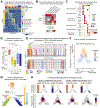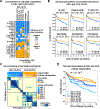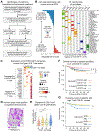The landscape of tumor cell states and ecosystems in diffuse large B cell lymphoma
- PMID: 34597589
- PMCID: PMC9205168
- DOI: 10.1016/j.ccell.2021.08.011
The landscape of tumor cell states and ecosystems in diffuse large B cell lymphoma
Abstract
Biological heterogeneity in diffuse large B cell lymphoma (DLBCL) is partly driven by cell-of-origin subtypes and associated genomic lesions, but also by diverse cell types and cell states in the tumor microenvironment (TME). However, dissecting these cell states and their clinical relevance at scale remains challenging. Here, we implemented EcoTyper, a machine-learning framework integrating transcriptome deconvolution and single-cell RNA sequencing, to characterize clinically relevant DLBCL cell states and ecosystems. Using this approach, we identified five cell states of malignant B cells that vary in prognostic associations and differentiation status. We also identified striking variation in cell states for 12 other lineages comprising the TME and forming cell state interactions in stereotyped ecosystems. While cell-of-origin subtypes have distinct TME composition, DLBCL ecosystems capture clinical heterogeneity within existing subtypes and extend beyond cell-of-origin and genotypic classes. These results resolve the DLBCL microenvironment at systems-level resolution and identify opportunities for therapeutic targeting (https://ecotyper.stanford.edu/lymphoma).
Keywords: CIBERSORTx; DLBCL; EcoTyper; diffuse large B cell lymphoma; digital cytometry; expression deconvolution; lymphoma; tumor ecosystems; tumor immunology; tumor microenvironment.
Copyright © 2021 Elsevier Inc. All rights reserved.
Conflict of interest statement
Declaration of interests D.M.K. reports paid consultancy from Roche Molecular Diagnostics. M.D. reports research funding from Varian Medical Systems and Illumina, ownership interest in CiberMed and Foresight Diagnostics, patent filings related to cancer biomarkers, and paid consultancy from Roche, AstraZeneca, RefleXion, and BioNTech. A.M.N. reports ownership interest in CiberMed and patent filings related to cancer biomarkers. A.A.A. reports research support from Bristol Meyers Squibb, ownership interest in CiberMed, FortySeven Inc., and Foresight Diagnostics, patent filings related to cancer biomarkers, and paid consultancy from Genentech, Roche, Chugai, Gilead, and Celgene. C.B.S., B.A.L., A.J.G., A.M.N., and A.A.A. have filed patent application PCT/US2020/059,196. The remaining authors declare no competing interests.
Figures







Comment in
-
Dissecting bulk transcriptomes of diffuse large B cell lymphoma.Cancer Cell. 2021 Oct 11;39(10):1305-1307. doi: 10.1016/j.ccell.2021.09.006. Epub 2021 Sep 30. Cancer Cell. 2021. PMID: 34597590
References
-
- Alizadeh AA, Eisen MB, Davis RE, Ma C, Lossos IS, Rosenwald A, Boldrick JC, Sabet H, Tran T, Yu X, et al. (2000). Distinct types of diffuse large B-cell lymphoma identified by gene expression profiling. Nature 403, 503–511. - PubMed
-
- Altschul SF, Gish W, Miller W, Myers EW, and Lipman DJ (1990). Basic local alignment search tool. J Mol Biol 215, 403–410. - PubMed
-
- Alvaro T, Lejeune M, Salvado MT, Lopez C, Jaen J, Bosch R, and Pons LE (2006). Immunohistochemical patterns of reactive microenvironment are associated with clinicobiologic behavior in follicular lymphoma patients. J Clin Oncol 24, 5350–5357. - PubMed
Publication types
MeSH terms
Grants and funding
LinkOut - more resources
Full Text Sources
Other Literature Sources
Molecular Biology Databases

